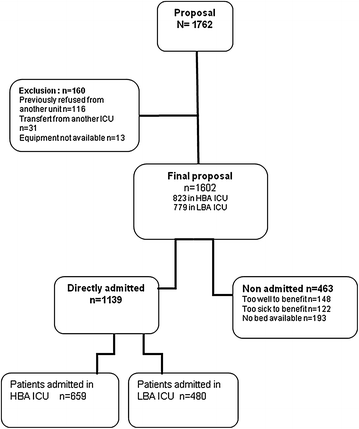Influence of ICU-bed availability on ICU admission decisions
- PMID: 26714805
- PMCID: PMC4695477
- DOI: 10.1186/s13613-015-0099-z
Influence of ICU-bed availability on ICU admission decisions
Abstract
Background: The potential influence of bed availability on triage to intensive care unit (ICU) admission is among the factors that may influence the ideal ratio of ICU beds to population: thus, high bed availability (HBA) may result in the admission of patients too well or too sick to benefit, whereas bed scarcity may result in refusal of patients likely to benefit from ICU admission.
Methods: Characteristics and outcomes of patient admitted in four ICUs with usual HBA, defined by admission refusal rate less than 11 % because of bed unavailability, were compared to patients admitted in six ICUs with usual low bed availability (LBA), i.e., an admission refusal rate higher than 10 % during a 90-day period.
Results: Over the 90 days, the mean number of days with no bed available was 30 ± 16 in HBA units versus 48 ± 21 in LBA units (p < 0.01). The proportion of admitted patients was significantly higher in the HBA (80.1 %; n = 659/823) than in the LBA units [61.6 %: n = 480/779; (p < 0.0001)]. The proportion of patients deemed too sick to benefit from admission was higher in LBA (9.0 %; n = 70) than in the HBA (6.3 %; n = 52) units (p < 0.05). The HBA group had a significantly greater proportion of patients younger than 40 years of age (22.5 %; n = 148 versus 14 %; n = 67 in LBA group; p < 0.001) and higher proportions of patients with either high or low simplified acute physiologic score II values.
Conclusions: Bed availability affected triage decisions. Units with HBA trend to admit patients too sick or too well to benefit.
Keywords: Admission; Bed occupancy; ICU; Refusal; Scarcity; Triage.
Figures
References
-
- Angus DC, Kelley MA, Schmitz RJ, White A, Popovich J. For the Committee on Manpower for Pulmonary and Critical Care Societies (COMPACCS) Current and projected workforce requirements for care of the critically ill and patients with pulmonary disease: can we meet the requirements of an aging population? JAMA. 2000;284:2762–2770. doi: 10.1001/jama.284.21.2762. - DOI - PubMed
-
- Annane D, Diehl JL, Drault JN et al. Reanimation. 2012;22(Suppl 3):ppHS2-HS23.
LinkOut - more resources
Full Text Sources
Other Literature Sources
Miscellaneous


